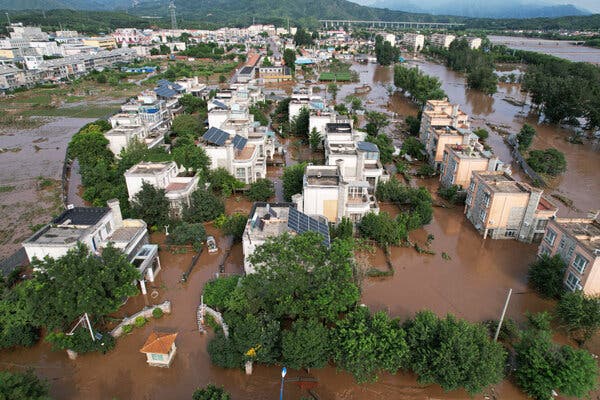Residents of Taishitun, a rural township roughly 70 miles northeast of central Beijing, initially showed little concern when the rains began. The area, situated on a flat plain distant from mountainous terrain that might cause mudslides, had no recent record of flooding.
Although Taishitun lies near the meeting point of three rivers, the closest—Qingshui River—is located about a quarter mile away and drains into a large downstream reservoir.
The community was stunned when, in the early hours of July 28, the Qingshui River abruptly breached its flood barriers, unleashing a powerful surge of water through the streets. Residents scrambled onto rooftops and alerted neighbors as the floodwaters advanced.
One of the earliest structures to be submerged was the Taishitun Elderly Care Center. Of the 69 residents, 55 were partially or fully immobile and relied on the eight staff present that day for assistance. The single-story nursing home soon found itself under six feet of water.
Firefighters arrived around 7 a.m. but were quickly overwhelmed by currents flowing faster than Niagara Falls at their peak. Rescue efforts only commenced three hours later. State media footage showed rescuers swimming with ropes into the nursing home to reach those clinging to windowsills, but tragically, many residents had already lost their lives. The death toll reached 31, shocking the capital and beyond.
“Honestly, nobody expected this,” said Cai Xiaokui, 49, a resident of Putaoyuan village near the nursing home. “Even elders in our village, some over 70 or 80 years old, have never witnessed weather this severe since childhood.”
As China faces more intense and unpredictable weather driven by climate change, the tragedy in Beijing’s Miyun District has exposed admitted weaknesses in local emergency planning. Authorities issued a rare apology and urged that all flood prevention and disaster relief measures be rigorously enforced.
Rising global temperatures and shifting ocean currents have increased rainfall in northern China, traditionally an arid region. A June report from China’s Ecology and Environment Ministry noted that precipitation in northern China last year was 83 percent above the 1991–2020 average.
The recent floods across Beijing and neighboring Hebei Province resulted in at least 60 deaths and forced more than 80,000 people from their homes. This marks the fifth extreme rain event to impact the area over the past 15 years.
Nationwide, flash floods have at least doubled compared to levels before 2000, according to Guangtao Fu, a water systems expert at the University of Exeter.
Previous major floods in Beijing during 2012, 2016, and 2023 primarily affected southern districts. However, this year’s rains struck further north, where residents and officials were less prepared.
Prior to the flooding, the region experienced five consecutive days of heavy rain, with some parts of Miyun receiving nearly a year’s worth of precipitation. This deluge, combined with rainfall upstream in the Ganyu Valley, caused the Qingshui River’s flow to reach record-breaking levels—1,500 times its normal rate by the morning of July 28.
The overwhelming surge swept through Taishitun, uprooting trees and vehicles before rushing downstream to the Miyun Reservoir, which was already at its highest capacity since its construction in the 1960s. Authorities had issued a red alert—the highest level—48 hours earlier, but no evacuation orders were given.
Following the nursing home fatalities, Beijing officials held a press conference where they apologized and disclosed that more than 16,000 residents in Miyun had been evacuated through door-to-door efforts—though the nursing home had not been reached.
“The town center where the nursing home is located was considered safe for a long time,” said Yu Weiguo, secretary of the Miyun District Committee. “This reveals shortcomings in our emergency plans and a limited understanding of extreme weather.” Officials observed a moment of silence during the announcement.
China’s Meteorological Administration stated two days after the tragedy that accurately forecasting such extreme weather remains a global challenge and pledged to enhance its early warning systems.
The disaster has struck a chord in a country where many families grapple with elder care. Social media users shared videos calling for improved nursing home safety and greater attention to caring for aging relatives.
“The Miyun incident underscores the failure of disaster responses based solely on past experiences,” wrote Lu Jingsheng, a professor at Renmin University’s School of Business, in an article posted on WeChat. “A civilized society must uphold responsibility toward its most vulnerable members.”
Following earlier floods, Beijing authorities invested in urban drainage upgrades and installed pumps in low-lying areas, according to Ma Jun, an environmentalist and founder of the Beijing-based Institute of Public and Environmental Affairs.
“There are still hard lessons to learn,” Ma said. “Monitoring gaps persist, and early warning forecasts remain less precise than desired.”
The Qingshui River, like many northern Chinese rivers, has been dredged and engineered to improve flood control. However, experts argue that traditional flood prevention—such as building higher flood walls and lining rivers with concrete embankments—can worsen disasters by reducing the land’s ability to absorb water.
“We must restore ground permeability and remove concrete surfaces,” stated Kongjian Yu, a landscape architect and professor at Peking University. “Change is necessary, yet engineers continue to erect taller flood walls.”
Flooding in the northwestern province of Gansu has claimed 15 lives, prompting national leadership to order full rescue efforts for over 30 people still missing.
After floodwaters subsided in Putaoyuan, residents reported foul odors from dead fish and animals, and homes remained coated in mud. Despite the devastation, many praised neighborly rescue efforts.
Locals used front-end loaders to evacuate residents from rooftops and guided emergency crews on inflatable boats. Cai, who operates a guesthouse, offered free lodging to rescue workers, and local restaurants provided free meals to affected residents.
“The sense of community solidarity is strong,” Cai said. “Usually neighbors might have minor disputes, but during such crises, people truly come together selflessly.”


0 Comments
No comments yet. Be the first to comment!